Abstract
Introduction
Monogeneans of the genus Paradiplozoon were found on the gills of specimens of five species of schizothoracid caught using fyke nets in the upper stream of the Yarkand River, Xinjiang, China in May–August 2019.
Methods
The preserved parasite were stained with boric acid magenta and hematoxylin, respectively. Morphological observations, line drawings, photomicrographs and measurements were made in Nikon ECLIPSE E200 imaging optical microscope and digitally edited. The molecular analysis included the study of the sequence of the second internal transcribed spacer (ITS 2) of the ribosomal DNA region, calculation and analysis of genetic distance, with phylogenetic reconstructions based on the Bayesian inference and Maximum Likelihood analysis.
Results
The natural infection rate of host fish was 10–88%. Morphological analysis indicated that the average length of the new species was 2.125 mm while the width was 0.69 mm. The anterior part was 1.387 mm in length and the average length of the posterior part was 0.545 mm. The vitellaria was well-developed and located in the front of the body. A single ovary (oval shaped) was located at the back end of the reproductive binding area. A testis (irregular mass) was located behind or parallelled to the ovary. The new species can be distinguished from all the recorded Paradiplozoon species in terms of morphological characteristics such as haptor, clamp and central hook morphology, intestine shape and body size. In addition, the second internal transcribed spacer (ITS 2) of the ribosomal DNA region of the diplozoid was compared with that of known diplozoids previously published. It indicated that there were significant differences between the new species and the published diplozoids.
Conclusion
Both morphological and molecular analysis support that the diplozoid is a new species. Based on the sampling location, the new species was named Paradiplozoon yarkandense n. sp.





Similar content being viewed by others
References
Khotenovsky IA (1985) Suborder Octomacrinae Khotenovsky. Fauna of the USSR. Monogenea. New Series. Zoological Institute, Russian Academy of Sciences, Moscow, pp 356–384 (in Russian)
Gläser HJ (1832) Gläser B (1964) Zur Taxonomie der Gattung Diplozoon Nordmann. Z Parasitenkd 25(2):164–192. https://doi.org/10.1007/BF00259955
Matějusová I, Koubková B, Gelnar M, Cunningham CO (2002) Paradiplozoon homoion Bychowsky & Nagibina, 1959 versus P. gracile Reichenbach-Klinke, 1961 (Monogenea): two species or phenotypic plasticity. Syst Parasitol 53(1):39–47. https://doi.org/10.1023/A:1019945921143
Milne SJ, Avenant-Oldewage A (2012) Seasonal growth of the attachment clamps of a Paradiplozoon sp. as depicted by statistical shape analysis. Afr J Biotechnol 11(9):2333–2339. https://doi.org/10.5897/AJB11.3064
Matějusová I, Koubková B, D’Amelio S, Cunningham CO (2001) Genetic characterization of six species of diplozoids (Monogenea; Diplozoidae). Parasitology 123:465–474. https://doi.org/10.1017/S0031182001008617
Matějusová I, Koubková B, Cunningham CO (2004) Identification of European diplozoids (Monogenea, Diplozoinae) by restriction digestion of the ribosomal RNA internal transcribed spacer. J Parasitol 90(4):817–822. https://doi.org/10.1645/GE-138R
Civáňová K, Koyun M, Koubková B (2013) The molecular and morphometrical description of a new diplozoid species from the gills of the Garra rufa (Heckel, 1843) (Cyprinidae) from Turkey—including a commentary on taxonomic division of Diplozoidae. Parasitol Res 112(8):3053–3062. https://doi.org/10.1007/s00436-013-3480-6
Avenant-Oldewage A, Le RLE, Mashego SN, Jansen VVB (2014) Paradiplozoon ichthyoxanthon n. sp. (Monogenea: Diplozoidae) from Labeobarbus aeneus (Cyprinidae) in the Vaal river, South Africa. J Helminthol 88(2):166–172. https://doi.org/10.1017/S0022149X12000879
Dos Santos QM, Jansen VVB, Avenant-Oldewage A (2015) Paradiplozoon vaalense n. sp. (Monog-enea: Diplozoidae) from the gills of moggel, Labeo umbratus (Smith, 1841), in the Vaal River System, South Africa. J Helminthol 89(1):58–67. https://doi.org/10.1017/S0022149X1300059X
Dos Santos QM, Avenant-Oldewage A (2016) The description of a new diplozoid species, Paradiplozoon krugerensen sp. from Labeo rosae Steindachner, 1894 and Labeo congoro Peters, 1852 in the Kruger National Park, South Africa with notes on the effect of water quality on its infection variables. Hydrobiologia 777(1):225–241. https://doi.org/10.1007/s10750-016-2776-9
Yue PQ, Chen YF, Cao WX et al (2000) Fauna Sinica (Osteichthyes): Cypriniformes III. Science Press, Beijing, pp 273–390 (in Chinese)
He DK, Chen YF, Chen YY, Chen ZM (2004) Molecular phylogeny of the specialized schizothoracine fishes (Teleostei: Cyprinidae), with their implications for the uplift of the Qinghai-Tibetan plateau. Chin Sci Bull 49(1):39–48. https://doi.org/10.1360/03wc0212
Guo Y, Zhang RM, Cai LG (2012) The fishes of Xinjiang. Science and Technology of Xinjiang Press, Urumqi, pp 106–130 (in Chinese)
Al-Nasiri FS, Balbuena JA (2016) Paradiplozoon iraqensis n. sp. (Monogenea: Diplozoinae) from Cyprinion macrostomum (Cyprinidae) in the Tigris River, Iraq. Acta Parasitol 61(2):291–298. https://doi.org/10.1515/ap-2016-0039
Pečínková M, Vøllestad LA, Koubková B, Huml J, Jurajda P, Gelnar M (2007) The relationship between developmental instability of gudgeon Gobio gobio and abundance and morphology of its ectoparasite Paradiplozoon homoion (Monogenea). J Fish Biol 71(5):1358–1370. https://doi.org/10.1111/j.1095-8649.2007.01599.x
Bachellerie JP, Liang HQ (1993) Ribosomal RNA probes for detection and identification of species. Methods Mol Biol 21:249–263. https://doi.org/10.1385/0-89603-239-6:249
Thompson JD, Gibson TJ, Plewniak F, Jeanmougin F, Higgins DG (1997) The ClustalX windows interface: flexible strategies for multiple sequence alignment aided by quality analysis tools. Nucleic Acids Res 25(24):4876–4882. https://doi.org/10.1093/nar/25.24.4876
Kimura M (1981) A simple method for estimating evolutionary rate of base substitutions through comparative studies of nucleotide sequences. J Mol Evol 16(2):111–120. https://doi.org/10.1007/BF01731581
Posada D, Crandall KA (1998) Model test: testing the model of DNA substitution. Bioinformatics 14(9):817–818. https://doi.org/10.1093/bioinformatics/14.9.817
Gu X, Fu YX, Li WH (1995) Maximum likelihood estimation of the heterogeneity of substitution rate among nucleotide sites. Mol Biol Evol 12(4):546–557. https://doi.org/10.1093/oxfordjournals.molbev.a040235
Felsenstein J (1985) Confidence limits on phylogenies: an approach using the bootstrap. Evolution 39(4):783–791. https://doi.org/10.1111/j.1558-5646.1985.tb00420.x
Ronquist F, Huelsenbeck JP (2003) MrBayes 3: Bayesian phylogenetic inference under mixed models. Bioinformatics 19(12):1572–1574. https://doi.org/10.1093/bioinformatics/btg180
Wu BH, Lang S, Wang WJ, et al (2000) Fauna China, Platyhelminthes, Monogenoidea. Science Press, Beijing (in Chinese). https://species.sciencereading.cn/biology/v/bookInfo/122/DW/1906790.html
Wang X, Jiao L, Jia SA, Wang N, Hao CL, Zhu MY, Yue C (2014) A new record of Diplozoidae in China. Arid Zone Res 31(6):1121–1124. https://doi.org/10.1386/j.azr.2014.06.21
Bai JP, Wang JJ, Li J, Xu WJ, Fan LX (2014) A new species of genus Paradiplozoon parasitic in Sikukia flavicaudata from the Lancang River, Xishuangbanna, Yunnan. Sichuan J Zool 33(4):540–544. https://doi.org/10.3969/j.issn.1000-7083.2014.04.010
Wang X, Jiao L, Yao WJ, Hao CL, Yue C (2015) The first record of a newly reported Chinese Diplozoidae of Monogenea on fishes in the Ergis River. Acta Hydrobiol Sin 39(4):794–797. https://doi.org/10.7541/2015.104 (in Chinese)
Fan LX, Meng FY, Bai JP, Xu WJ, Wang X (2018) Paradiplozoon yunnanensis n. sp. (Monogenea, Diplozoidae) from Sikukia gudgeri (Cyprinidae, Barbinae) in southwest China. Parasite 25:1–9. https://doi.org/10.1051/parasite/2018047
Yamaguti S (1963) Systema Helminthum, vol IV. In: Monogenea and Aspidocotylea. Interscience Publishers, New York
Fischthal JH, Kuntz RE (1963) Trematode parasites of fishes from Egypt. Part II. Diplozoon aegyptensis n. sp. (Monogenea: Polyopisthocotylea: Diclidophoroidea) from Labeo forskalii. Proc Helminthol Soc Wash 30:31–33. https://doi.org/10.2307/3275682
Brun NL, Renaud F, Lambert A (1988) The genus Diplozoon (Monogenea, Polyopisthocotylea) in southern France: speculation and specificity. Int J Parasitol 18(3):395–400. https://doi.org/10.1016/0020-7519(88)90150-6
Sicard M, Desmarais E, Lambert A (2001) Molecular characterization of Diplozoidae populations on five Cyprinidae species: consequences for host specificity. Comptes Rendus De Lacademie Des Sci 324(8):709–717. https://doi.org/10.1016/S0764-4469(01)01352-X
Mendlová M, Šimková A (2014) Evolution of host specificity in monogeneans parasitizing Africa cichlid fish. Parasit Vectors 7(1):1–24. https://doi.org/10.1186/1756-3305-7-69
Vásquez AG, Mendivil UR, Godoy MR (2015) Morphological and molecular description of eight new species of Gyrodactylus, von Nordman, 1832 (Platyhelminthes: Monogenea) from poeciliid fishes, collected in their natural distribution range in the Gulf of Mexico slope, Mexico. Parasitol Res 114(9):3337–3355. https://doi.org/10.1007/s00436-015-4559-z
Nitta M, Nagasawa K (2016) A new species of Dactylogyrus (Monogenea: Dactylogyridae) parasitic on an endangered freshwater fish, Rhodeus atremius atremius, endemic to japan. Parasitol Int 65(5):483–487. https://doi.org/10.1016/j.parint.2016.06.014
Jirsová D, Ding XJ, Civáňová K, Jirounková E, Ilgová J, Koubková B, Kasny M, Gelnar M (2018) Redescription of Paradiplozoon hemiculteri (Monogenea, Diplozoidae) from the type host Hemiculter leucisculus, with neotype designation. Parasite 25(4):1–8. https://doi.org/10.1051/parasite/2018004
Ahmad F, Fazili KM, Sofi TA, Waza AA, Rashid R (2015) Comparative molecular characterization of three Diplozoon species from fishes of Kashmir valley. Agric Adv 4(7):65–83. https://doi.org/10.1419/aa.v4i7.1919
Gao Q, Chen MX, Yao WJ, Gao Y, Song Y, Wang GT, Wang MX, Nie P (2007) Phylogeny of diplozoids in five genera of the subfamily Diplozoinae Palombi, 1949 as inferred from ITS-2 rDNA sequences. Parasitology 134(5):695–703. https://doi.org/10.1017/S0031182006001971
Acknowledgements
The authors would like to thank all the laboratory members for their help on the experiment. We thank Prof. Ling-Gang Cai and Jian-Gong Niu, Mr. Hong Liu from Xinjiang Fishery Research Institute for their help during the field studies and fish catching. Our thanks also to Prof. Jun Zou from Shanghai Ocean University and Prof. Hwa-Chain R. Wang from University of Tennessee for English correction and suggestion.
Funding
This work was supported by the Natural Science Foundation of China (Grant No. 31860738 and No. 31960737).
Author information
Authors and Affiliations
Corresponding author
Ethics declarations
Conflict of Interest
The authors declare that they have no conflict of interest.
Ethics Approval
All procedures contributing to this work comply with the ethical standards of the relevant national and institutional guides on the care and use of laboratory animals and the study was approved by the Animal Care and Use Committee of Xinjiang Agricultural University (Grant No. 2019021).
Additional information
Publisher's Note
Springer Nature remains neutral with regard to jurisdictional claims in published maps and institutional affiliations.
Supplementary Information
Below is the link to the electronic supplementary material.
11686_2021_466_MOESM1_ESM.tif
Supplementary file1 Fig. S1. Morphological comparison of (a) Paradiplozoon krugerense quoted by Dos Santos (2016) and (b) Paradiplozoon bingolensis quoted by Civáňová (2013) (TIF 5074 KB)
Rights and permissions
About this article
Cite this article
Arken, K., Hao, CL., Guo, AM. et al. A New Species of Paradiplozoon (Monogenea: Diplozoidae), A Gill Parasite of the Schizothorax Fish (Cyprinidae: Schizothoracinae) from the Yarkand River, Xinjiang, China. Acta Parasit. 67, 330–339 (2022). https://doi.org/10.1007/s11686-021-00466-5
Received:
Accepted:
Published:
Issue Date:
DOI: https://doi.org/10.1007/s11686-021-00466-5




